This history was written by members of the graduating class of 1942. They look back to the beginning of Carleton Elementary School in 1895
A Short History of Carlton School
1895 – 1945
Compiled by a committee of Grade 8 pupils: J. Petty, P. Hamill, R. Chattey, E. Neville, E. Henderson, I. Green, A. Arai and D. Balsion – directed by Mr. E. A. Harris.
Vancouver, B.C. 1942
A Short History of Carlton School
1895 – 1945
Acknowledgement
We would have been unable to compile this record if it had not been for the help given by Mr. A. Martin, principal of Carleton School, Miss L. E. Hindle and Miss R. MacRae, teachers for more than twenty five years at Carleton. We acknowledge help give by such Collingwood old-timers as Mr. C. Battison, Mrs. P Oban and others. Also we wish to thank Major Matthews, City Archivist, for his courtesy and assistance in furnishing historical material of Vancouver’s early days.
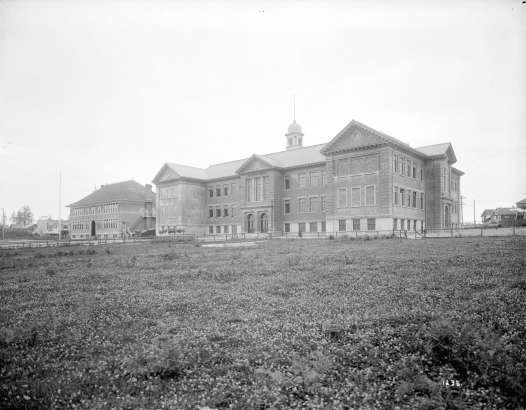
A History of Carleton School
The year was 1895. Vancouver was not yet ten years old. It had recovered from the disastrous fire of 1886 and was rapidly becoming a thriving little city. Trains arrived on schedule and were no longer a novelty – more and more ships were making use of the port – and the population was increasing steadily
Nevertheless, the city still had the appearance of a settlement on the edge of the wilderness. Between Vancouver and New Westminster thee was a considerable forest with some bug trees still standing but much of the area had been logged off and fire had swept through some parts of it. The road from Vancouver to New Westminster was unpaved – it was called the Westminster Road or sometimes the “Black Road” because of the many charred stumps. You would not see cars and buses travelling at high speed, instead you would see horse-drawn vehicles and pedestrians. Along the route were scattered settlements like Collingwood, which we believe was called after the roadhouse of that name at Central Park. At such place thirsty and weary travelers would stop for refreshment. These settlements were connected by the inter-urban in 1891. Incidentally this was the first electric railway in Canada, if not in North America. Some of the pioneers of Collingwood are remembered by streets which have been maned after them. For example: Joyce Road, Battison Street, Kerr Road, Doman Road, MacKinnon Street, Earl”s Road perpetuate the names of some of the pioneer families.
Notes: At a “Tree planting Ceremony” Trees were planted in front and sides of school for old families and named after them. Dogwoods were planted by entrance classes after the First World War. Two memorial trees were planted in front of the school in memory of Mr. Lothian and Mr. Hyndman, teachers who lost their lives while on an outing with pupils.
At that time (1895) there was no school, so Reeve George Ray of the Municipality of South Vancouver, (which had been organized in 1892) and several of the fathers had a meeting and decided that they would petition for a school. Several names were on the petition and it was sent to the Department of Education at Victoria. As it would take time to build a school, they decided to have a school-room in one of the houses while the school was being built. The first school-room was in the front of Mr. Peter Dubois’ store on Westminster Road (Kingsway), (corner of Lincoln Street).
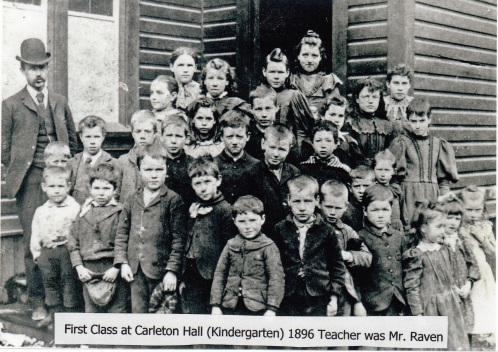
The first teacher was Mr. Martin Ravey who had secured his teacher certificate in 1894. Later, Mr. DuBois wanted to use his store, so the school-room was moved to Mr. John Connan’s home on Battison St. at Kingsway for a few months until the new school was erected. The following were pupils at the EAST VANCOUVER SCHOOL, as it was officially known, during the frirst term from October 25th to December 20th, 1895: Gertrude Alcock, Ethel Alcock, Lawrence Alcock, Frederick Alcock, William Black, Annie Black, Ivy Bodaly, Elmer Bodaly, Lidney Cook, John Cook, Peter DuBois, Mainard DuBois, Florence May Earle, Wm. Earle, William McGatey, Lily Rae, Mabel Rae, Mabel Withrow, Edith Withrow, Joan Withrow, Charles Bailey, Nora Freedon, Martha Wallace, Martha Grimmer, Edward Robinson, George Franklin, Mabel Alcock, Frank Battison, Charle Battison, Harry Battison.
In 1896 the new building was finished, It was a typical one room structure, located at the corner of Joyce Road and Kingsway and is to-day (sic) known as Carlton Hall. The school board of that time consisted of Messrs. G.W. Stone, secretary, A. Joyce, (after whom Joyce Road is named) and H. Howard. It should be noted that although South Vancouver had been an organized municipality since 1892, It’s schools were government assisted and each had its local school board. Besides Vancouver East, there were schools known a South Vancouver (later Lord Selkirk, North Arm (later Moberley Annex) schools.
During 1896 and 1897 the school continued under the guidance of Martin Ravey. In the latter year he apparently left teaching for a business career. In August 1897 a new teacher was appointed at ta salary of $50.00 a month. His name was Michael MacMillan an on the school board of that year was G. W. Stone, secretary, A. Joyce and H. Howard. The school population was increasing, there being now forty-five pupils. Mr. MacMillan continued teaching at East Vancouver during 1898 and 1899 and according to the Inspector, Mr. F. M. Cowperthwaite, afterwards head of Vancouver’s schools, he did “good to excellent work”. The school enrolment had increased to forty-nine pupils. For some reason there was also a complete change in the school board membership, the three new officials being Messrs. J. H. Bowman, secretary, W.P. Brown and J. Nelson.
In September 1899, Mr. MacMillan resigned and was succeeded by Mr. R. M. Robson. The enrolment continued to increase and in 1901 a second division was opened. Miss L. A. Burpee, who later became primary instructress, at the Normal School, was appointed to the second division. For her services Miss. Burpee was paid fifty dollars a month while Me. Robson, principal of a two-room school, was paid sixty dollars a month. The school enrolment was now 63 pupils. In 1902 Mr. Robson left Vancouver East School and the school board, which consisted of Trustees Nelson, Bowman, and Stones, appointed Mr. J. A. Bates as principal;. The school enrolment increased by 10 pupils during `903. In December of that year Mr. Bates left to take a position at Cumberland, B.C. and Mr. Matthew Beattie became principal when the new term opened in January 1904. Changes were frequent in those days and in June 1904, Mr. Beattie moved to Ashcroft. Miss Burpee also transferred to Seymour School in Vancouver City. After a long and useful career, Mr. Beattie passed away only a few months ago. He was over eighty and had for some time been in honourable retirement. The summer of 1904 brought a complete change of staff to VAN. East school. Mr. E. F. Clarke was appointed principal and Miss Ella D. Perkins was place in charge of Division 2. Mr. Clarke, who had taught at Duncan and on the prairies, was completing a course at the Normal School during August and September. During those two months the substitute for him was a man whom this school was to know a great deal better a year or so later – His name was Mr. A. Martin.
East Vancouver was becoming a good-sized school by his time. By 1905, Division one had an enrolment of 44 pupils, and Division 2 had 48 pupils. Entrance to High School examinations were written twice a year. From East Vancouver School, Rita Smith passed in December, 1904 and Alex. McDonald passed in June 1905. In June also Miss Perkins left to take a position in the Lord Roberts school, in Vancouver.
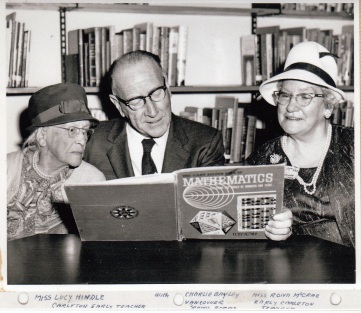
When school re-opened in August 1905, Mr. E. F. Clarke was still principal and the new teacher appointed to Division 2 was Hiss L. E. Hindle. As we write in June, 1942, Miss Hindle is still a member of the school staff, with Thirty-seven years of continuous service. Miss Hindle is a native of New Zealand and was born at a place near Auckland called Waiuku. She west to school in Queensland, Australia, and after coming to Canada in May 1902, she finished her education at the old Vancouver High School. Miss Hindle has kept up her interests in a great many things which probably explains why she remains an efficient teacher after so many years.
In 1906, local South Vancouver school boards were abolished, and the schools were placed under a municipal board. The first such board of school trustees consisted of Mr. R.C. Hodgdon, chairman, Mr. R. Wells, Mr. J. Jones, Mr. W.H. Eburne and Mr. G.F. Timms.
In 1906 the staff of East Vancouver School consisted o two teachers, Miss Hindle continued in charge of Division 2 but the was a new principal. He was Mr. Alexander Martin who had two years earlier substituted for Mr. Clarke.
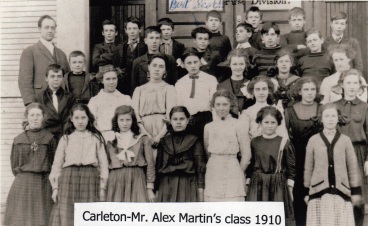
Today, in 1942, Mr. Martin can look back on more than thirty year as principal of this school. He was born and educated in Prince Edward Island and came to British Columbia in 1902. He took his teacher training in Vancouver. His first teaching was done at the Sandwick in the Comox Valley and at Lytton, B.C. Mr. Martin held the principalship for the ten years after 1906. In 1916 he went overseas, serving in France with the 7th Battalion. During his absence, in 1916 until 1919, the school was in charge of Mr. A.E.C. Martin (a namesake, but no relation to Mr. A. Martin) now of the Provincial Normal School. After the war, Mr. Marin returned and has remained as principal until the present year. Naturally, the school has taken much of his interest and he has taught several generations of Collingwood residents, but he has had time for some hobbies, one of which is, as he puts it, “poor golf”.
But we are getting ahead of ourselves. To return to 1907. In that year a third division was added with Miss Lydia Copeland as teacher. Her classes were at first held in the old Methodist Church (Billingham’s Store) but when a new wing was opened there was room for the third division in the main building. The enrollment had by this time increased to 122 and in April 1908, the name was changed to Collinwood Heights School.
The early 1900’s were “boom Times” in British Columbia and Vancouver in particular grew rapidly. This increase in population was considerable in South Vancouver. The enrolment at Collingwood Heights School increased rapidly.
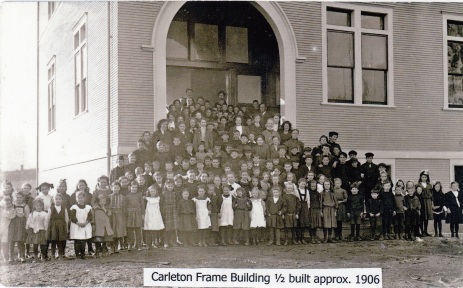
In 1908 the first section of the Frame Building, consisting of four rooms, was erected to accommodate the larger number of pupils.
The next year the remaining half was added. This is the eight room frame building which is still being used. Over crowding however persisted, — the new Frame building was full, and the various smaller structures which included what is now Carleton Hall, the Manual Training Building, which had once been the “East Wing” of Vancouver East School, and was now moved to the other end of the grounds, and what is now the janitor’s dwelling house were all occupied. Therefore, in 1910 the South Vancouver School board began the erection of permanent brick buildings. 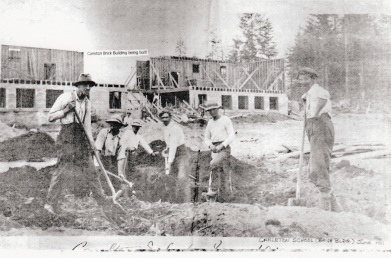
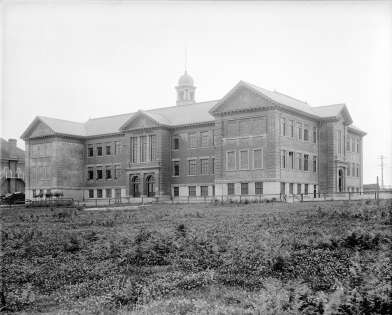 The central part was built first and the wings were added in 1912. In 1911, when part of the new brick structure was already being used, the name of the school was changed to “Carleton.” Apparently, the school trustees went to their history books for names as so many of the schools were named for important figures in Canadian history. Sir Guy Carleton, was, of course, the second governor of Canada after its capture by the British in 1763. In August 1913, manual training and domestic science were established at Carleton.
The central part was built first and the wings were added in 1912. In 1911, when part of the new brick structure was already being used, the name of the school was changed to “Carleton.” Apparently, the school trustees went to their history books for names as so many of the schools were named for important figures in Canadian history. Sir Guy Carleton, was, of course, the second governor of Canada after its capture by the British in 1763. In August 1913, manual training and domestic science were established at Carleton.
During the Great War, 1914 to 1918, Mr. Martin, as stated previously, served overseas and many Carleton ex-pupils did likewise. Amongst those who paid the supreme sacrifice were, Ben Bailey, Lindfrum Karr, Water Scott, Cecil Tyerman, Donald Reid, George Potter, and Ferdinand Bristol. In the present conflict many former Carleton pupils are in the armed forces, — including the air force, the navy and merchant navy as well as the army. At least one T. Haines, is a prisoner of war in Germany.
For some time, as has been shown, Carleton had been one of the largest elementary schools in Vancouver. (South Vancouver and Point Grey municipalities amalgamated with the City of Vancouver in 1929.) At one time there were as many as twenty-seven divisions, with the brick building, frame building, and old Carleton Hall, filled to aver-flowing. In the Brick Building one class was located on the main landing. Thousands of children and more than a hundred teachers have spent some of their years at Carleton. Vancouver School principals who at one time taught here may be mentioned: Messrs. Thornber, (deceased), Warden, (retired), Wate, Clarke, Lightbody, Godfrey, Sims, and R. Smith. At the present time there are eighteen divisions with twenty teachers, including Manual Training and Domestic Science, for an enrolment of more than seven hundred pupils.
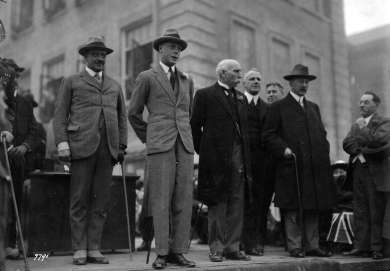 Mr. Martin’s Visitors’ Book contains many well-known names covering a period of 36 years. One signature in the book is that of Edward, Prince of Wales. Now the Duke of Windsor, dated Sept. 29th, 1919. Most of South Vancouver’s pupils were gathered on Carleton School grounds to greet him. The Prince stepped from his car, shook hands with the principals of several schools and with some of the pupils as he walked down the rows. He gave a short speech and was presented with a bouquet by Phyllis Michelmore. Another important visitor was the Duke of Connaught when he was Governor-general of Canada.
Mr. Martin’s Visitors’ Book contains many well-known names covering a period of 36 years. One signature in the book is that of Edward, Prince of Wales. Now the Duke of Windsor, dated Sept. 29th, 1919. Most of South Vancouver’s pupils were gathered on Carleton School grounds to greet him. The Prince stepped from his car, shook hands with the principals of several schools and with some of the pupils as he walked down the rows. He gave a short speech and was presented with a bouquet by Phyllis Michelmore. Another important visitor was the Duke of Connaught when he was Governor-general of Canada. 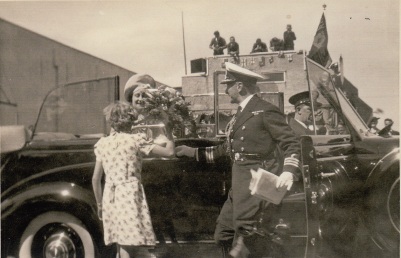 More recently in 1939, the coming of King George and Queen Elisabeth created a great event. After touring the city, the Royal Car stopped at Carleton School. The streets were lined with pupils, parents and teachers.
More recently in 1939, the coming of King George and Queen Elisabeth created a great event. After touring the city, the Royal Car stopped at Carleton School. The streets were lined with pupils, parents and teachers.
Beverly Dean presented the queen with a bouquet of flowers. Other names in the Visitor’s Book include those of Colonel A. Graham, former municipal inspector, Mr. J. A. Gordon, former superintendent of Vancouver Schools, Me. H.N. MacCorkindale, the present holder of that position, and others.
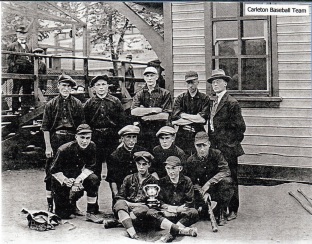 In athletics, Carleton boys and girls maintained a high reputation and the case on the landing contains a fair showing of cups – although cup-winning was not the main incentive to play. Soccer and baseball have been played since the school started, more than one well-known Vancouver player received his education at Carleton.
In athletics, Carleton boys and girls maintained a high reputation and the case on the landing contains a fair showing of cups – although cup-winning was not the main incentive to play. Soccer and baseball have been played since the school started, more than one well-known Vancouver player received his education at Carleton. 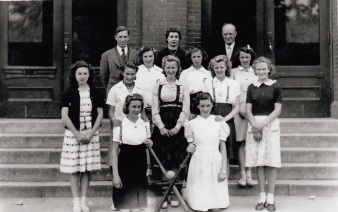
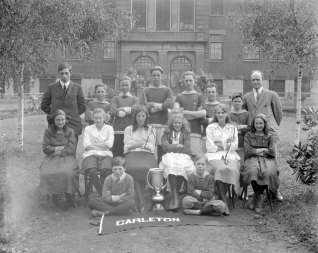 In the early days the girls used to play a form of baseball using a tennis racquet and a tennis ball. The boys also played nobbies and lacrosse. In recent times softball has been the most popular gave and because of this has one of the largest play-grounds in the city – as many as twenty-four games may be going on at one time. Marbles and hop-scotch are popular pastimes during the proper season.
In the early days the girls used to play a form of baseball using a tennis racquet and a tennis ball. The boys also played nobbies and lacrosse. In recent times softball has been the most popular gave and because of this has one of the largest play-grounds in the city – as many as twenty-four games may be going on at one time. Marbles and hop-scotch are popular pastimes during the proper season.
In their studies, Carleton pupils have kept up to good standard. In the 1932 High School Entrance examination Noel Owen won the Governor-general’s medal for Proficiency. Other pupils, on several occasions, have missed it by only a few marks. However, when Mr. Martin was asked about any particularly outstanding pupil, he replied they were all outstanding.
For a good many years Carleton has had a useful Parent-Teacher Association which has assisted the school in a great many ways, such as supplying milk to under-nourished children, providing sports equipment and library books, etc. By no means least in P.T.A. activities is the Graduation Party for Grade Eight students.
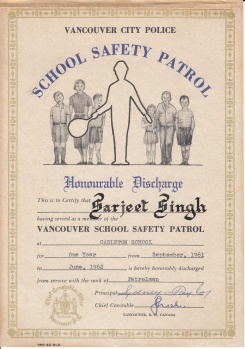 Located as it is on Kingsway, the traffic on that busy street is dangerous. In 1941 a Boy’s Patrol was formed and has worked efficiently during the year. Mayor Cornett and other officials came to inaugurate this first Boy’s Patrol to operate on Kingsway.
Located as it is on Kingsway, the traffic on that busy street is dangerous. In 1941 a Boy’s Patrol was formed and has worked efficiently during the year. Mayor Cornett and other officials came to inaugurate this first Boy’s Patrol to operate on Kingsway.
The year 1942. Many changes have taken place in the forty-seven years of the school’s existence. Vancouver has grown up and Carleton School has grown with it. Kingsway is no longer a dirt road but a paved main highway and Carleton has developed from a one –room school to more than twenty rooms. But, if our brief and sketchy record must end here, the work of the school in training young Canadians will still go on.
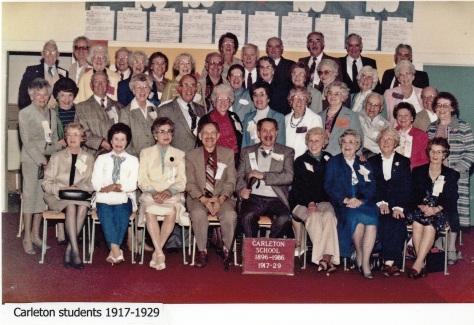
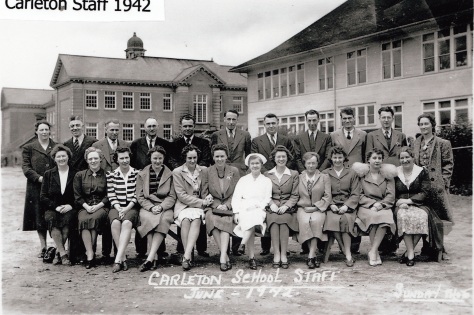 _________________________________________________________________
_________________________________________________________________
(Cover by Ronnie Snowden)
Warden Watt.
